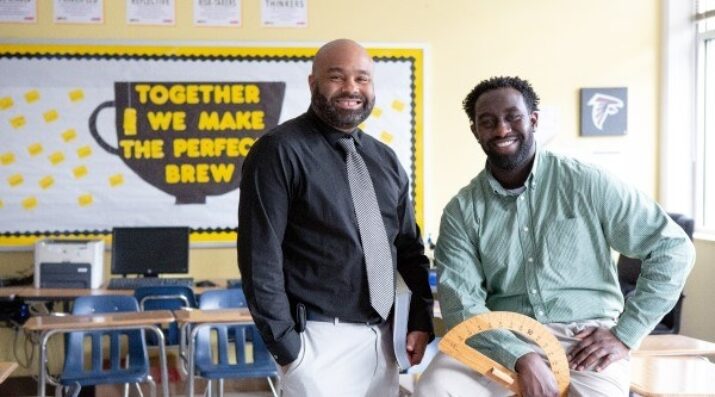A Single Slice of the Pie: Relieving Educator Overwhelm by Consolidating Roles and Expanding Opportunities for Teacher Leadership
Topics

When educators design and create new schools, and live next gen learning themselves, they take the lead in growing next gen learning across the nation. Other educators don’t simply follow and adopt; next gen learning depends on personal and community agency—the will to own the change, fueled by the desire to learn from and with others. Networks and policy play important roles in enabling grassroots approaches to change.
Teacher exhaustion is not new but it is now pervasive. Greater autonomy and consolidating roles can support educator wellness and strengthen school culture.
Educator stories of overwhelm and exhaustion are continuing to create buzz across education social media circles. The same school-level and systemic factors from the 1990s and 2000s hold true today as major sources of stress, including but not limited to high-stakes testing, excessive workload, large class sizes, inadequate resources, student behavioral challenges, initiative fatigue, and lack of support. One of the most cited contributing factors to educator attrition is educators wearing too many hats (Viac & Fraser, 2020).
Many educators have asked their schools to consider taking tasks off their plates. Because of the many requirements that schools have to meet at the district and state levels, we know that this is often not possible.
What is possible for schools, however, is the opportunity to consolidate educator roles. Doing this not only helps alleviate the pressure that educators feel when trying to juggle many roles, but it also provides teachers an opportunity to step into teacher leadership. Take a moment to think about the following examples:
- A school asks an educator to shift to an SEL coordinator position that works collaboratively with teachers to support students.
- An educator really enjoys writing lessons and aligning them with standards, and they feel empowered to take on a role where that is their sole job, working collaboratively with teachers to support them across various classrooms.
- An educator loves working with students to set academic goals and coaching and networking them to achieve those goals, so they take on a coaching position that supports all or a portion of students in the school. Or perhaps they take on a position coordinating and supporting a group of coaches.
- An educator takes on a coordinator role of a project-based learning approach for students that additionally frees up teachers to serve as mentors for certain components of student projects.
We hear often of excellent teachers who we wish could influence more than the students in their building. Another prevalent narrative is of teachers’ wish to revise or update their skills and courses, which they would happily do if they had the time and opportunity. The following example demonstrates how local and state support is helping one talented business teacher reach more students by giving her the space to learn and grow. With triangulated support this teacher is currently (a) leveraging her brick-and mortar teaching experience to (b) design useful and usable learning opportunities in virtual courses. As she does so, this teacher is (c) increasing access to both the course content and her talent, (d) building both her individual and the school’s capacity to support learners in virtual environments, and most importantly (e) recognizing that her past experience is valuable. By building a dynamic and relevant virtual course, this educator is simultaneously honing her craft while teaching more students in increasingly relevant ways.
A talented brick-and-mortar business teacher took on the brave challenge of working with a digital pedagogist to design a virtual course. She is using her years in the classroom to re-envision what learning and teaching look and feel like for the purpose of developing up-to-date, useful, and usable virtual curriculum so that more students have access to the content she teaches.
However, the teacher’s confidence to realize this goal was, at times, unsteady. Significant institutional constraints and already impacted professional routines were compounding in unsustainable ways. As a veteran teacher of a course that had recently been moved one whole grade level down, she found herself designing assignments that met the standards but were somewhat lacking in relevance given the developmental difference between the age of her former students and the age of her current ones. This combined with the challenges of learning to teach in a virtual environment and the rest of her professional responsibilities was making it difficult to focus on the challenge she undertook. In fact, the overwhelm was making the whole job difficult.
When asked how she might re-envision her role to help her focus on design and generally escape the overwhelm, the teacher envisioned letting go of enough other responsibilities to spend time updating her courses; her courses would facilitate relevant learning in both brick-and-mortar and virtual learning environments. She would consolidate her role to center around curriculum design. To try on this role consolidation, the teacher and the pedagogist spent 45 minutes brainstorming strategies the teacher could use to engage students in meaningful learning of useful and usable concepts in both learning environments.
Throughout the working session, this teacher let her creativity flow. She developed curricular approaches that (a) meet academic standards, (b) address students’ needs, (c) draw on learner’s expertise, and (d) could be made appropriate for both face-to-face and virtual settings. Her tone turned joyful as she innovated. She began designing new materials and teaching strategies. It became apparent that, if allowed to do what she loves and is trained to do—that is, if she could re-envision her role to be one that gave her enough space to creatively design —both she and her students would experience learning that is useful and usable, valuable to those learners, and valued by others. The experience is helping this teacher—and the school—build the capacity to consolidate her role, which in turn is beginning to relieve the overwhelm and reinvigorate her excitement for teaching.
And because this teacher has the local and state support to continue working and learning in this way, she is able to focus her energy on something she is passionate about (relevant curriculum design) while increasing her school’s (and the state’s) capacity to ensure students’ access to it.
This option of role consolidation also illustrates the power of educator autonomy: opening up space for educators to innovate and be creative. When educators feel empowered and supported, their job satisfaction rises, and subsequently, they are more likely to stay (OECD 2014; OECD 2019). We see this role consolidation not only as a way to retain educators but also as an opportunity to bolster educators and strengthen school culture. We’d love to hear your examples of role consolidation as a method of lightening educators’ loads. Share your creative ideas with kathryn@well4edu.org and, with your permission, we’ll feature them in future blog posts.
Image at top by Allison Shelley for EDUimages, CC BY-NC 4.0.




